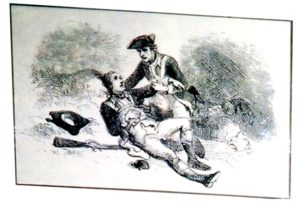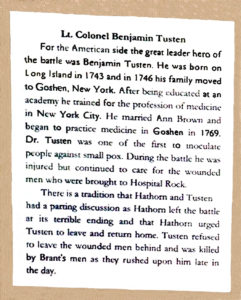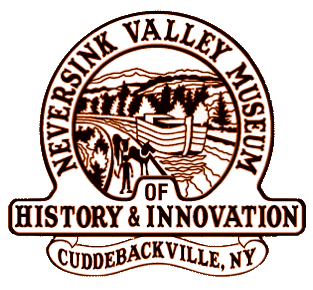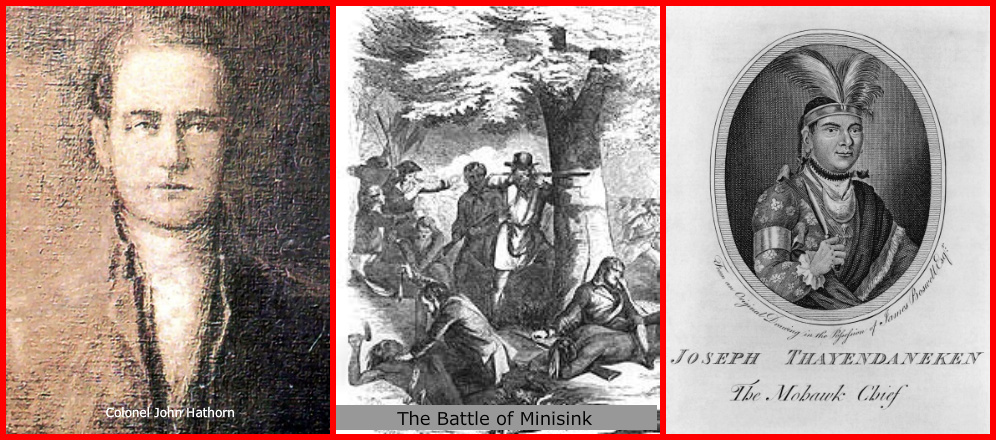
- This event has passed.
The Neversink Valley Museum Wednesday Night History Talks on THE BATTLE OF MINISINK REVISITED with DR. RICHARD HULL @ 7PM
October 19, 2016 @ 7:00 pm
The Battle of Minisink Revisited:
Conflicting Perceptions and Fresh Interpretations of its Cause, the Conflict, and Its Catastrophic Consequences
by Dr. Richard Hull, Professor Emeritus, New York University
The talk will critically examine the tragic 1779 Battle of Minisink taking the conflicting perspectives of its combatants: a local American revolutionary militia, a unit of Empire Loyalists, and a band of Native American fighters. Professor Hull will weigh the accounts of its participants focusing of its key actors: Mohawk Colonel Joseph Brant and Warwick revolutionary Colonel John Hathorn. He will then set their views in a broad context of historically-recurring issues of rebellion, land possession, race and ethnicity ,and cultural diversity, Over the generations there has been much myth, legend and raw emotion surrounding this pivotal Revolutionary War conflict. Dr. Hull will argue for a more balanced interpretation. The talk promises to be thought provoking, eye-opening, and innovative in its approach.
ARTICLE FROM TIMES HERALD RECORD
On July 20, 1779, Joseph Brant, Mohawk chief and British Army colonel, led a raiding party of Indians and Tories against the settlement at Minisink, near present-day Port Jervis.
Brant, an astute military tactician, had learned that a Colonial Army detachment under Count Pulaski, which had been assigned to defend the sparse settlements in the Mamakating, Neversink and Delaware valleys, had been re-deployed elsewhere, leaving the area largely unprotected. Brant’s objective was to gather livestock, produce and whatever other provisions he could find and stockpile them in order to help the British and their Indian allies camped out in the Susquehanna Valley survive the following winter. If he could devastate and demoralize the settlers and distract the Colonials from their fight with the regular British Army, all the better.
Having completed the raid, plundering and burning homes, killing the men and dispersing the women and children, Brant and his men took their bounty and returned northward, along the Delaware, on their way back to the Susquehanna.
Word of the raiding party soon reached Goshen, where the call went out for the militia to gather under the leadership of a local physician, Col. Benjamin Tusten.
After hotly deliberating the merits of engaging the marauders in combat, Tusten and 149 men – merchants, farmers and clerks, and what James Eldridge Quinlan later described as “some of the principal gentlemen of the county” – set out the next day in pursuit of their quarry.
“Colonel Tusten was opposed to risking an encounter with the subtle Mohawk chief with so feeble a command,” Quinlan wrote, “especially as the enemy was known to be greatly superior to them in numbers. The Americans were not well provided with arms and ammunition, and it was wise to wait for reinforcements. “Others, however, were for immediate pursuit. They held the Indians in contempt, insisted that they would not fight, and declared that a recapture of the plunder was an easy achievement.
“The excited militia men took up their line of march, and followed the old Kathegton (Cochecton) trail 17 miles, when they encamped at Skinner’s mill, near Haggie’s Pond, about three miles from the mouth of Halfway Brook.” The following morning, July 22, 1779, Tusten and his men, bolstered by a contingent from Warwick under the command of Col. John Hathorn, finally confronted Brant on the banks of the Delaware just above present-day Barryville.
Almost immediately, Brant deftly cut the militia’s force in two and an epic battle ensued on a hilltop overlooking the river.
Ammunition was soon depleted, and the combat was reduced to hand-to-hand, with the Mohawks and Tories getting much the better of it. The militia was routed, and nearly all of those who stayed and fought were killed, including Tusten.
Following the bloody daylong battle, Brant and his remaining men forded the river and continued on their journey. They somehow managed to avoid the severe retribution for their actions administered a few weeks later by Gen. John Sullivan and his army of 3,000, who swept through Wawarsing, Mamakating and Deerpark, through Easton and Tioga Point, and destroyed anything Iroquois they encountered along the way.


The remains of those slain on that desolate Barryville hilltop in what forever after would be known as the Battle of Minisink were not afforded a proper burial. Quinlan wrote that “for 43 years the bones of those who had been slain on the banks of the Delaware were permitted to molder on the battle ground. But one attempt had been made to gather them, and that was by the widows of the slaughtered men, of whom there were 33 in the Presbyterian congregation of Goshen. They set out for the place of battle on horseback, but finding the journey too hazardous, they hired a man to perform the pious duty, who proved unfaithful and never returned.”
Finally, in 1822, “a committee was appointed to collect the remains and to ascertain the names of the fallen. The committee proceeded to the battle ground, a distance of 46 miles from Goshen, and viewed some of the frightful elevations and descents over which the militia had passed when pursuing the red marauders. The place where the conflict occurred, and the region for several miles around, were carefully examined and the relics of the honored dead gathered with pious care. The remains were taken to Goshen, where they were buried in the presence of 15,000 persons.”
A monument was erected to mark the mass grave, upon which was inscribed the names of the 44 men killed in the battle.
Unfortunately, as meticulous as the search for remains had been, only 300 bones were recovered, far fewer than had been expected. Nature and the denizens of the forest had no doubt disposed of the rest.
This sad occurrence moved the Monticello poet Alfred B. Street to write in the final stanza of his 10-stanza commemorative of the battle:
“Years have pass’d by, the merry bee
Hums round the laurel flowers,
The mock-bird pours its melody
Amid the forest bowers;
A skull is at my feet, though now
The wild rose wreathes its bony brow,
Relic of other hours,
It bids the wandering pilgrim think
Of those who died at Minisink.”
John Conway is the Sullivan County historian and an adjunct professor of history at Sullivan County Community College in Loch Sheldrake. He lives in Barryville.
Short Link:

